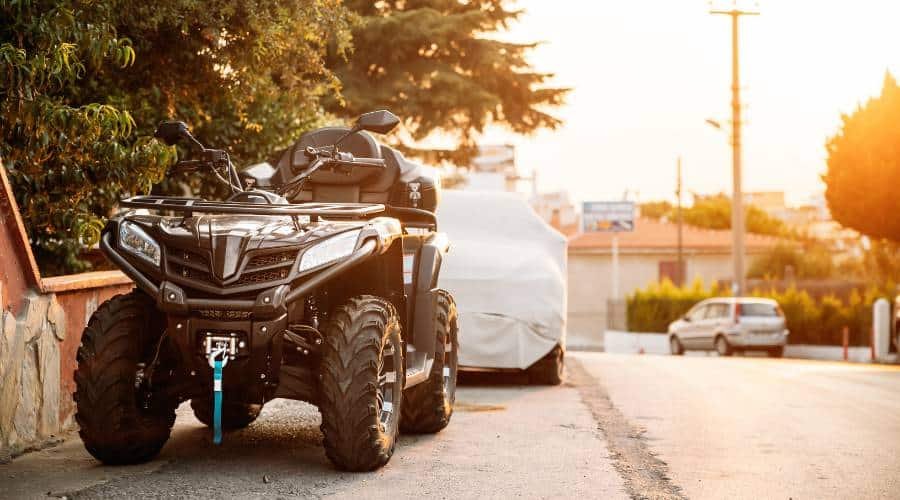Have you ever wondered how fast electric ATVs can go? Or whether they’re street-legal? These questions are becoming increasingly important as more people turn to electric vehicles for transportation and recreation.
It may surprise you to learn that some high-end electric ATVs can reach speeds of up to 50 mph, which is comparable to many gas-powered models currently on the market. However, speed is not the only concern for potential electric ATV riders. A common problem for those interested in electric ATVs is understanding their legal status.
In this post, we’ll explore the top speeds of electric ATVs and discuss the laws and regulations surrounding their use on public roads. We’ll also compare electric ATVs with gas-powered ATVs and provide tips on how to stay safe while riding.
So, whether you’re considering purchasing an electric ATV or simply curious about its capabilities, keep reading to find out more.
How Fast Can an Electric ATV Go?

The answer to this question varies depending on the model and the manufacturer. Most electric ATVs have a top speed of around 20-30 mph (32-48 km/h). This is slower than gas-powered ATVs, which can reach speeds of up to 80 mph (128 km/h) or more. However, electric ATVs are generally quieter, more efficient, and produce fewer emissions than their gas-powered counterparts.
Some high-performance electric ATVs on the market can reach speeds of up to 50 mph (80 km/h), but these are generally more expensive and not suitable for beginners or younger riders. In general, the speed of an electric ATV is limited by its battery capacity and motor power. The more powerful the motor and the larger the battery, the faster the ATV can go.
It’s important to note that the speed of an electric ATV should always be kept within safe limits. Riders should wear appropriate safety gear such as helmets and protective clothing and adhere to local speed limits and regulations.
What Makes an Electric ATV Fast?
When it comes to electric ATVs, several factors can affect their speed. The following are some of the things that make an electric ATV fast:
🔲 Motor Power: The power of the electric motor in an ATV is the primary factor that determines its speed. A more powerful motor produces more torque, which translates to higher speeds. Generally, the higher the wattage of the motor, the faster the ATV can go.
🔲 Battery Capacity: The battery’s capacity is another critical factor that determines the speed of an electric ATV. A larger battery capacity means more power is available to the motor, allowing the ATV to maintain its speed for longer periods. A higher-capacity battery will also allow your electric ATV to travel longer distances before needing a recharge.
🔲 Controller: The controller regulates the power output of the motor, which affects the ATV’s speed. A high-quality controller can provide better acceleration and top speed than a low-quality controller.
🔲 Weight: The weight of an electric ATV can also impact its speed. Lightweight electric ATVs, when compared to heavier models, can generally accelerate more quickly and reach higher speeds. This is because they require less power from the motor to move. Manufacturers often use lightweight materials like aluminum or carbon fiber to reduce the overall weight of the ATV.
🔲 Terrain: The terrain also plays a significant role in determining the speed of an electric ATV. Steep inclines or rough terrain can slow down your electric ATV, while flat and smooth terrain can allow your e-ATV to achieve higher speeds.
🔲 Aerodynamics: The design of an electric ATV can impact its speed. A more streamlined design can reduce drag, allowing the ATV to move faster.
When choosing an electric ATV, it is crucial to consider the above-mentioned factors to select a model that meets your speed and performance requirements.
Are Electric Quad Bikes Road Legal?

The answer to this question depends on several factors, including the type of electric quad bike and the location where it will be used. In many countries, electric quad bikes are not considered road legal and are only permitted for off-road use. However, there are some exceptions, and regulations may vary from state to state and country to country.
In the United States, electric quad bikes are not classified as highway vehicles and therefore are not legal for road use. However, some states may allow them to be used on public roads under specific conditions, such as limited speed and use on designated routes. It’s important that you go through your state’s ATV laws before taking your electric quad bike out on the road.
In the United Kingdom, electric quad bikes can be road legal if they meet certain requirements. They must be registered with the Driver and Vehicle Licensing Agency (DVLA) and have a valid license plate. The vehicle must also be insured, and the rider must have a valid driver’s license and wear a helmet.
In conclusion, the legality of electric quad bikes on public roads varies depending on the country and region. It is essential to check the local laws and regulations before purchasing an electric quad bike to ensure that it can be used legally. Even if an electric quad bike is legal for road use, it is important to use the vehicle responsibly and follow all traffic laws and safety guidelines to prevent accidents and injuries.
How Much Power Do I Need on an Electric ATV?
When it comes to electric ATVs, power is one of the most important considerations. The power of an electric ATV is typically measured in watts or horsepower. The more power an electric ATV has, the more torque it can generate, and the faster it can accelerate. The power output of an electric ATV is determined by a combination of factors, including the motor’s size and type, battery capacity, and controller efficiency.
When determining how much power you need on an electric ATV, it is essential to consider your intended use and the terrain you will be riding on.
If you plan to use your electric ATV for recreational purposes, such as riding on flat terrain or cruising through trails, a lower-powered ATV may be sufficient. However, if you plan to use your electric ATV for racing, towing heavy loads, or navigating through steep hills and rough terrain, you will need a more powerful ATV with a higher horsepower and torque rating.
It is essential to consider these factors and choose an electric ATV with the appropriate power rating to ensure that it meets your needs and requirements.
Electric ATV vs Gas ATV: Comparison of Speed and Performance

Electric ATVs and gas-powered ATVs both have their unique advantages and disadvantages when it comes to speed and performance. Below we will compare the two types of ATVs and highlight the differences in speed and performance.
Speed
Electric ATVs are known for their quick acceleration and instant torque delivery, which means they can accelerate quickly from a standstill, giving them an edge over gas ATVs in short, quick bursts of speed.
In terms of top speed, however, gas ATVs generally have the advantage. Gas ATVs can reach higher speeds, typically up to 70-80 mph or more. Whereas most electric ATVs generally have a top speed of around 20-30 mph, with some high-end models providing a maximum top speed of 40-50 miles per hour.
This difference in top speed may not be significant for recreational riders, but it can be a deciding factor for those who plan to use their ATVs for racing purposes.
Performance
When it comes to performance, electric ATVs have some significant advantages over gas-powered ATVs. Electric ATVs are virtually silent and produce zero emissions, making them ideal for use in environmentally sensitive areas. They also require less maintenance than gas-powered ATVs, as they have fewer moving parts and do not require oil changes or tune-ups.
On the other hand, gas-powered ATVs have a significant advantage in terms of range and power. Gas-powered ATVs typically have a longer range than electric ATVs, allowing riders to cover more ground before needing to refuel. Refueling a gas ATV is also much quicker than recharging an electric ATV’s battery.
Gas-powered ATVs also have more power, which makes them better suited for towing heavy loads when compared to electric ATVs.
In conclusion, both electric ATVs and gas-powered ATVs have their strengths and weaknesses when it comes to speed and performance. It is essential to consider your intended use and personal preferences when choosing between the two types of ATVs.
How Fast Is A 500W Electric Quad?

A 500W electric quad typically has a top speed of around 10 to 15 miles per hour (16 to 24 kph). However, the actual speed may vary depending on several factors such as the terrain, rider’s weight, and battery capacity. For instance, the quad’s speed may decrease on hills and rough terrains, whereas it may increase on smooth surfaces.
The power output of an electric quad is measured in watts, and the higher the wattage, the more powerful the ATV is. A 500W electric quad falls under the low to medium power range and is suitable for kids and beginners. However, if you’re an experienced rider looking for more speed and power, you may want to consider an electric ATV with a higher-wattage motor.
How Fast Is A 1000W Electric Quad?
A 1000-watt electric quad is a popular option among electric ATV users as it can provide a decent level of speed and performance, especially for recreational use.
Generally speaking, Electric ATVs with 1000w motors typically have a top speed of about 20 to 25 miles per hour (32 to 40 kilometers per hour). However, this speed is achieved on flat, smooth terrain with a lightweight rider. On rough or steep terrain, the speed may be lower, and heavier riders may also experience slower speeds.
It’s important to note that different models of electric quads may have different speed capabilities, so it’s best to check the specifications of the specific model you’re interested in. Additionally, various factors can affect the speed of an electric quad, such as the riding conditions, so it’s important that you keep everything in mind before making a purchase.
How Fast Is Tesla ATV?
Although an adult version of Tesla’s ATV has not yet been released, the tesla cyberquad for kids was made available for purchase in December 2021. However, it only has a top speed of 10 miles per hour (16 kph), and a range of 15 miles per charge.
In November 2019, Tesla unveiled a new electric ATV as part of its cyber truck launch event. The ATV is designed to fit in the bed of the cyber truck and is marketed as a companion vehicle to the pickup truck.
During the unveiling event, Tesla CEO Elon Musk showed a video of the electric ATV in action, but he did not disclose any specific details regarding its speed or other performance metrics. However, based on the video footage, the electric ATV appears to be fast and powerful, with the ability to accelerate quickly and traverse various terrains.
It is important to note that the Tesla electric ATV is still in the development stage, and there is no information yet on its top speed or other performance metrics. However, given Tesla’s reputation for producing high-performance electric vehicles, it is likely that the electric ATV will be fast and powerful.
Safety Considerations for Electric ATVs

Like any motorized vehicle, electric ATVs can pose risks to riders if proper safety precautions are not taken. The following are some safety considerations to keep in mind when riding an electric ATV:
🔲 Wear Appropriate Safety Gear: This includes a helmet, gloves, boots, and protective clothing. The right safety gear can protect you from head injuries, abrasions, and other injuries that may result from accidents.
🔲 Be Aware of Your Surroundings: Always be aware of your surroundings and watch out for obstacles, other riders, and animals that may be on the trail.
🔲 Know Your Limits: Electric ATVs are powerful machines and can be dangerous if not operated properly. Know your limits and don’t attempt maneuvers or ride on terrains that are beyond your skill level.
🔲 Follow Manufacturer Guidelines: Make sure to read and follow the manufacturer’s guidelines and instructions for operating and maintaining your electric ATV. This can help prevent malfunctions and keep your ATV running smoothly.
🔲 Stay on Designated Trails: It is important to stay on designated trails and not ride in areas that are off-limits or prohibited. This helps protect the environment and prevent accidents.
🔲 Keep Your ATV Well-maintained: Regular maintenance is important to keep your electric ATV in good working order. Make sure to keep the battery charged, and check the tires, brakes, and other components regularly.
🔲 Don’t Ride Alone: It is always safer to ride with others, as you can help each other in case of an emergency.
By keeping these safety considerations in mind, you can enjoy the benefits of electric ATVs while minimizing the risk of accidents or injuries. Remember, safety should always be your top priority when riding an electric ATV.
FAQs
Do electric ATVs have the same power as gas-powered ATVs?
Electric ATVs can have similar power to gas-powered ATVs in terms of torque and acceleration, but they typically have lower top speeds and shorter ranges.
Can electric ATVs handle rough terrain?
Electric ATVs are typically designed to handle rough terrain and can be just as capable as gas-powered ATVs in terms of off-road performance.
Are electric ATVs street legal?
It depends on the specific laws and regulations in your area. In some areas, electric ATVs may be street legal if they meet certain requirements such as having a horn, headlights, taillights, and turn signals. However, in other areas, electric ATVs may only be allowed on private property or designated off-road trails.
Can I modify my electric ATV to make it street legal?
It is possible to modify an electric ATV to make it street-legal in some states. However, it can be a complex process and requires the ATV to meet specific safety and emissions standards.
Can I ride my electric ATV on private property?
You can generally ride your electric ATV on private property as long as you have permission from the property owner.

